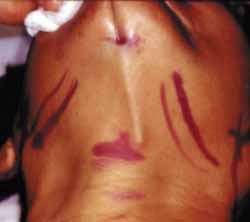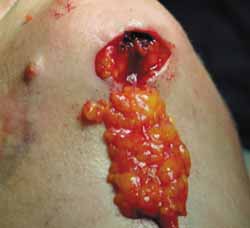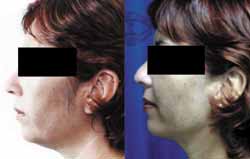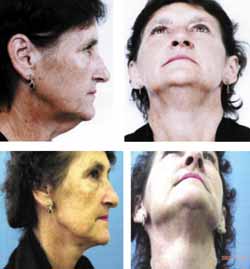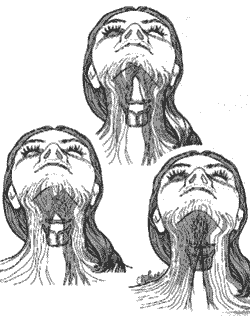

Year: 2004 Vol. 70 Ed. 5 - (3º)
Artigo Original
Pages: 597 to 601
ANTERIOR CERVICOPLASTY
Author(s):
Lucas Gomes Patrocínio1,
José Antônio Patrocínio2
Keywords: rythidoplasty, cervicoplasty, neck, plastic surgery.
Abstract:
Introduction: Many patients look for aesthetic correction of the laxity of neck skin, submandibular fat deposit or platisma bands. In a large part of the cases, medial action, through anterior cervicoplasty is necessary. Objective: To demonstrate the casuistic and to evaluate the results and complications with anterior cervicoplasty technique in the Otorhinolaryngology Service of the Federal University of Uberlândia. Patients and Methods: Forty-two patients, between 39 and 65 years of age, being 40 (95,2%) male and 2 (4,8%) female, were submitted to anterior cervicoplasty. Retrospectively, results and complications were appraised. Results: Of these patients, 34 presented satisfactory results, 4 presented aesthetic deficit only noticed by the surgeon, 3 presented aesthetic deficit only noticed by the patient and 1 presented aesthetic deficit needing revisional surgery. At photographic study, all the patients presented improvement of cervical profile, reduction of platisma bands and of skin laxity, stabilization of cervical musculature, and accentuation of cervicomental angle, in various degrees. There were two complications (discreet serohematoma and little enlarged scar). Conclusion: Anterior cervicoplasty, associated or not to lateral traction, is a technique that produces satisfactory results in the great majority of the cases.
![]()
INTRODUCTION
Rhytidectomy (lifting) or facial rejuvenation surgery is a procedure that has become increasingly popular among Otorhinolaryngologists. After developing expertise in rhinoplasty, they moved towards palpebra and ears conducting blepharoplasty and otoplasty. Currently, they have reached the remaining portions of the face and started working with Rhytidectomy.
Thirty years ago, the problems of submentalis fat deposits and formation of platysmal bands were inappropriately addressed with inferior facial third rejuvenation. It was an attempt to smooth platysma bands directed to applying tension to submentalis and neck skin using pre-auricular incisions. Excessive submentalis fat was not left untreated. Inevitably, there was recurrence of platysmal bands some months after the surgery, especially in patients with poor skin elasticity.
For this reason, some surgeons in the 60's started to treat submentalis skin redundancy associated with oblique cervicomandibular angle with direct anterior neck incision 1, 2, which left behind a visible scar. In the 70's, Weisman3 described a submentalis incision, with skin excision, through which he incised platysmal bands and fused them with zetaplasty. Others addressed platysmal bands by resecting the medial margins 4 or suturing lateral margins or muscle flaps on sternocleidomastoid muscle 5-7. Some techniques incorporated anterior plication of medial margins of platysma muscle 6, 8. Feldman expanded this idea in 1990 with the concept of formation of a corset of platysma through total suture of medial margins of platysma muscle 9. Ramirez10 modified some of the described techniques and introduced new concepts in the anterior non-excision neck approach.
Currently, the standard approach for rejuvenation in the submentalis area is variation of corset platysmaplasty associated with lipectomy with removal of excessive submentalis fat under and over the platysma muscle, which can also be followed by liposuction.
Technical advances allow impressive esthetical results in isolated and associated procedures, improving the results of traditional surgeries. We describe here a technique of anterior cervicoplasty and our cases, assessing results and associated complications.
MATERIAL AND METHODS
Patients
From January 2001 to January 2004 the Service of Otorhinolaryngology, Federal University of Uberlandia performed 152 rhytidectomy. Out of the total, 52 patients were submitted to anterior cervicoplasty (associated with lateral traction in 30 cases). Patients were aged 39 to 65 years, 40 (95.2%) were female and 2 (4.8%) were male subjects.
All patients underwent clinical examination and were carefully selected before the conduction of the surgery. The following criteria were used: young patients with obtuse cervicomental angle, wide neck with excessive neck fat, or elderly with elastic skin, small platysmal bands and little neck fat. Surgery was contraindicated in patients with mild laxity, absence of platysmal band, acute cervicomental angle, middle age with large platysmal bands and skin without elasticity, elderly with platysmal bands and neck folds, bull neck, micrognathia with indication for orthognathic surgery, and/or submandibular gland ptosis.
Patients came for follow-up visits on days 7, 30, 60 and 180 after surgery and were reassessed concerning complications. In the last visit, patients were asked about general satisfaction level with the surgical result, whereas final esthetical result was appreciated by the medical staff.
All patients signed the informed consent term according to the approval of the protocol submitted to the Ethics Committee of the center.
Surgical Technique
The surgery was performed under local anesthesia with infiltration of lidocaine at 2% with adrenaline 1:200,000 and mild sedation with phentanyl and midazolam. The patients were positioned at dorsal position with posterior flexion of the head. The surgeon was placed behind the patient's head, such as in tonsillectomy, supported by frontal focus light.
Using a blade-15 knife, an incision 3-4cm long was made on the submental fold. Using Metzenbaum scissors, supported by Aufrich expander, a dissection was made leaving a thick subcutaneous flap. The limits of the dissection were mandible line, anterior band of sternocleidomastoid muscle and cricoid cartilage (Fig. 1). Lipectomy was conducted over platysma, mylohyoid and digastric muscles, resecting a fat band of 2 x 5 cm (Fig. 2). Platysma muscle was dissected with resection and approximation of anterior margins of midline, from thyroid cartilage to mandible symphysis, and suture with Ethybond 2-0, continuous and anchored, from top down up to thyroid cartilage and restarting from bottom up with simple continuous suture. Afterwards, we sectioned platysma muscle with a cautery, obliquely and inferiorly 3 -4 cm to each side, on the upper margin of thyroid cartilage. We sutured the subcutaneous incision with Vicryl 4-0 and skin with continuous suture with Prolene 5-0. Compressive dressing with micropore and stitches were maintained for 7 days 11.
RESULTS
Final subjective assessment of surgery depends on the viewpoint of patients and surgeons, which may differ in some cases. Out of 42 patients, 34 presented satisfactory results, 4 had esthetical deficit detected only by the surgeon, 3 had esthetical deficit detected only by the patient, and 1 presented esthetical deficit that required revision surgery.
Upon analyzing the photographs, all patients presented improvement of neck profile, reduction of platysma bands and skin laxity, stabilization of neck muscle and accentuation of cervicomental angle at varied degrees (Fig. 3 and 4).
Revision surgery was necessary in one patient that reported little improvement after surgery. We conducted removal of more subcutaneous tissue and the final result was satisfactory.
There were complications in 2 cases. One patient presented mild serohematoma that required drainage and another patient presented a scar slightly enlarged. There were no complications such as formation of keloids, hypo and hyperpigmentation, incision granuloma, platysma muscle paralysis and skin necrosis.
DISCUSSION
Platysma muscle is a thin and flat muscle that contributes to facial expression and ranges in size, thickness and elasticity. It has direct correlation with mandible, superficial muscle-aponeurotic system (SMAS), pectoralis and deltoid muscles. Owing to its action, skin on the neck gets shrank and mouth canthus is pulled downward, conveying the expression of disgust. In most cases, its fibers are tangled in the midline, under the mentalis, in the anterior neck region. In 10 to 15% of the subjects, it does not happen, which could favor the formation of bands when people approach the age of 40 years 12 (Fig. 5).
The action of platysma muscle depends on the anatomy of the muscle, mandible and neck, position of hyoid bone, size of thyroid cartilage and amount of fat.
Platysma muscle can be approached differently, depending on the abnormalities present: a) Elevation and advance of head posterior region with excision or midline affections; b) L flap with lateral partial excision; c) Lateral partial excision, plication and medial section; d) Total excision and medial plication.
Lateral partial excision of platysma is indicated when there is no definition about the posterior line of the mandible, in moderately thin necks and with mild or moderate laxity of platysma muscle. Wide excision of platysma, 6cm below the mandible and up to thyroid cartilage, has its indications in cases of narrow mandible, thick neck and fat face.
Intervention may be medial by anterior cervicoplasty such as we described, laterally or both simultaneously. The technique for medial access to platysma muscle consists of lipectomy, vertical resection of medial redundant bands and medial plication 13,14.
Anterior cervicoplasty is a simple accessory procedure that can be associated with lifting and should be part of our surgical options. In cases with proper indication, it can be associated with lifting and improve considerably the surgery, because the tendency today is to combine two or more techniques to obtain long-lasting results. The most common reasons that motivate male patients to look for plastic repair are attempts to improve neck folds and eliminate submentalis fat deposits.
Acting on platysma muscle and submentalis fat, through small incision under the anterior and inferior region of mandible, we can obtain a considerable adjuvant esthetical effect. This action depends on amount of submental and submandibular fat present, platysma bands and cervicomental angle 15.
Patients selected for the use of this isolated technique should have good skin tonus, with mild to moderate amount of fat.
It is indicated to young people with obtuse cervicomental angle, thick neck and fat. It can also be indicated in middle-aged or elderly patients with elastic skin, little fat and small platysma band, those who had already been submitted to traditional cervicoplasty and persist without cervicomental angle, people who have already undergone liposuction of the region with poor results, cases of mild microgenia with indication of implant.. In severe microgenia, we should associate cervicoplasty with genioplasty 10.
Isolated anterior cervicoplasty is contraindicated in mild laxity or absence of platysma muscle bands, normal cervicomental angle, in middle-aged patients with large platysma bands and skin without elasticity, in elderly with platysma bands and skin folds on the neck, in bull neck, in micrognathia with indication for orthognathic surgery, in submandibular gland ptosis 10.
Anterior cervicoplasty has advantages: quickness, less trauma, elimination of bands, reduction of laxity, stabilization of cervical muscle tension, cervical angle deepening, does not cause problems of flap vascularization, has good acceptance by young people because there is no posterior scar, and people do not "seem they have been operated on" "16,17.
The association of anterior margin plication of digastric muscle with Ethybond 2-0 causes a counter-tension in the posterior muscle belly, elevating and bringing back the hyoid muscle. Since men have skin laxity earlier, the result is better in women than in men at the same age range 10.
Despite the indications and limited access, if cervicoplasty is used in the right patients, the results are comparable to that of open excision techniques 10,17,18.
CONCLUSION
We concluded that cervicoplasty, associated or not with lateral traction by rhytidectomy, is a technique that produces satisfactory results in most of the patients, promoting improvement of neck profile, reduction of platysma bands and skin laxity, stabilization of neck muscles and accentuation of cervicomental angle.
REFERENCES
1. Johnson JB, Hardley RC. The aging face. In: Converse JM, ed. Reconstructive Plastic Surgery. Philadelphia: W.B. Saunders; 1964. p. 1328.
2. Cronin TD, Biggs TM. The Z-plasty for the "turkey globber" neck. Plast Reconstr Surg 1971; 47(6):534-438.
3. Weisman P. A simplified technique in submental lipectomy. Plast Reconstr Surg 1971; 48(5):443-446.
4. Millard DR Jr, Garst WP, Beck RL, Thompson ID. Submental and submandibular lipectomy in conjunction with a face lift, in the male or female. Plast Reconstr Surg 1972; 49(4):385-391.
5. Baker TJ, Gordon HL, Whitlow DR. Our present technique for rhytidectomy. Plast Reconstr Surg 1973; 52(3):232-236.
6. Connell BF. Eyebrow, face, and neck lifts for males. Clin Plast Surg 1978; 5(1):15-28.
7. Gerrero-Santos J. The role of the platysma muscle in rhytidectomy. Clin Plast Surg 1978; 5:29-49.
8. Rees T.D. Face-Lift. In: Rees TD, Wood-Smith D, eds. Cosmetic and Facial Surgery. Philadelphia: W.B. Saunders; 1973. p. 203.
9. Feldman JJ. Corset platysmaplasty. Plast Reconstr Surg 1990; 85:333-343.
10. Ramirez OM. Cervicoplasty: nonexcisional anterior approach. Plast Reconstr Surg 1997; 99(6):1576-85.
11. Patrocínio JA, Patrocínio LG. Cervicoplastia Anterior. In: Stamm A (editor). Rhinology 2002. Campinas: Komedi; 2002. p. 321-4.
12. Fehrenbach MJ, Herring SW. Músculos. In: Fehrenbach MJ, Herring SW, eds. Anatomia Ilustrada de Cabeça e Pescoço. Bela Vista: Manole; 1986. pp. 103-106.
13. Mangat DS, Mcollough EG. Rhytidectomy. In: Cummings CW, ed. Otolaryngology Head and Neck Surgery. St. Louis: Mosby; 1986. pp. 409-427.
14. Maniglia JJ. Cirurgia do Rejuvenescimento Facial. In: Colombini N, ed. Cirurgia da Face: Interpretação Funcional e Estética. São Paulo: Revinter; 2001. pp. 1253-1271.
15. Kamer FM, Pieper PG. Facelift: a facial plastic surgeon's perspective. In: Romo III T, Millman AL, eds. Aesthetic Facial Plastic Surgery. New York: Thieme Medical Publishers; 2000. pp. 171-187.
16. Keller GS, Cray JE. Percutaneous video-endoscopic necklift with suture suspension platysmaplasty. In: Keller GS, ed. Endoscopic Facial Plastic Surgery. St. Louis: Mosby; 1997. pp. 137-156.
17. Knize DM. Limited incision submental lipectomy and platysmaplasty. Plast Reconstr Surg 1998; 101(2):473-81.
18. Del Campo AF. Midline platysma muscular overlap for neck restoration. Plast Reconstr Surg 1998; 102(5):1710-4.
Figure 1 - Photo showing marking of flap elevation limits, incision site, and infiltration of local anesthetic agent.
Figure 2 - Photo showing lipectomy. Piece 2 x 5 cm from midline.
Figure 3 - Lateral view of female 44 -year-old patient with excessive submental fat, platysma bands, obtuse cervicomental angle and skin laxity. Postoperative (5th month) and side view of anterior cervicoplasty demonstrating excellent mandibular line, acute cervicomental angle, absence of platysma bands and skin laxity, with good proportion of lower facial third.
Figure 4 - Frontal (upper, left) and lateral (upper, right) views of female 58-year old patient with excessive submental fat, few platysmal bands, obtuse cervicomental angle and little skin laxity. Frontal (lower, left) and lateral (lower, right) postoperative image (6th month) and anterior cervicoplasty demonstrating regular mandibular line, appropriate cervicomental angle, absence of platysma bands, and skin laxity, with good proportion of lower facial third.
Figure 5 - Figure demonstrating the types of conformation of platysma muscle with approach of midline.
